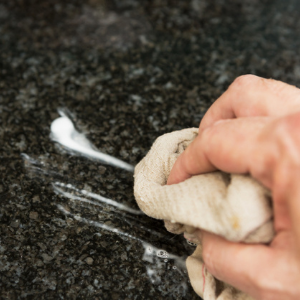How to Care for Honed Granite Countertops in 4 Easy Steps

There’s no denying the modern appeal of a honed finish, which adds a lot of visual texture to your design, while also presenting a more subtle aesthetic than a high gloss finish. Instead of bouncing light, this finish absorbs it, allowing you to highlight other aspects of your design if you don’t necessarily want the countertops to scream for attention.
While polished granite speaks to a certain upscale elegance, honed granite has a more casual appeal that emphasizes the grain and richness of granite in a completely different way. It contributes to the relaxed ambiance many homeowners want in their kitchens, bathrooms, or other spaces.
With that being said, honed granite does require a different level of care than a polished surface.
What are some of the cleaning and maintenance challenges you might face with honed granite? How can you properly care for your natural stone countertops and keep them looking gorgeous for years to come?
Here’s what you should know before choosing this countertop finish.
Step #1: Daily Cleaning
Like most kitchen countertops, your honed granite will endure the wear and tear of daily use, mainly from meal preparation, so frequent cleaning is vital. The feature that makes honed granite a little different than polished stone is the texture, which can impact how often you feel you need to clean it.
While you might expect a textured surface to hide dust, grime, fingerprints, and water spots better than a glossy, polished surface, the opposite is actually true. Honed granite does tend to conceal minor scratching, etching, and similar damage, but superficial spotting can actually be more noticeable.
All this really means for practical purposes is that you’ll want to wipe down your countertops after use, which you’d probably do anyway to remove food prep remnants, fingerprints and dust that’s settled on the surface.
This can be easily accomplished by simply swiping a damp sponge or rag over the surface, followed by a dry microfiber cloth to prevent water spots.
Step #2: Addressing Messes
Kitchens, bathrooms, laundry rooms, outdoor bar areas, and other surfaces are prone to all kinds of messes. If you don’t wipe them up immediately, you will likely find yourself dealing with accumulated grease or food residue that a damp rag just can’t contend with. So, how can you restore the silky finish of your honed granite?
As with polished granite, all you need is a mixture of mild dish soap and warm water and a soft cloth or sponge – perhaps along with a little elbow grease. Never use abrasive detergents or tools on your granite countertop, as these can etch the surface, damage the sealant, and cause much more serious and long-lasting problems.
The important thing to remember when you use soap on natural stone countertops is that you need to rinse the surface thoroughly with clean water afterward. If soap residue remains on your counter surface, it could cause a cloudy film to develop.
Although a matte finish already has a certain dull quality when compared to a highly-reflective, polished surface, soap build-up could still obscure the beauty and character of your natural stone countertops over time.
Again, make sure to follow up washing and rinsing by wiping a dry microfiber cloth over the surface to soak up any remaining water. Microfiber is not only highly absorbent, but it’s also lint-free.
As an alternative, you can look for solvents that are specifically designed to clean natural stone surfaces. This will eliminate several steps in the process. Some cleansers even help to preserve the seal on your countertops!
Step #3: Treating Stains
Stains are always a concern with natural stone countertops because they are porous. Proper sealing can do a lot to prevent damage, but if you notice stains from food like pasta sauce, coffee, or wine, for example, there are steps you can take to treat them.
A simple paste of baking soda and water is a good place to start. Mix it to a thick, spreadable consistency, apply it to the stained area, and rub it gently with a sponge or a soft-bristled brush.
If this doesn’t completely remove the stain, you can set the paste, cover it with plastic food wrap, tape down the edges, and leave it for 24 hours before wiping away. Follow stain removal with a quick rinse and wipe with a dry microfiber cloth.
Step #4: The Importance of Regular Sealing
Maintaining the sealant on a honed counter surface is incredibly important, as the texture makes it slightly more porous and therefore more susceptible to damage like etching and staining. While it is generally recommended that you seal polished granite annually, you may want to seal honed granite two to four times a year. Sealing needs depend entirely on usage and wear and tear. You should seal your granite, as needed, which could be more or less often than recommended. However, with proper care, your beautiful, natural stone will last a lifetime.
Are you interested in upgrading to eye-catching granite countertops? Start by checking out the Academy Marble & Granite portfolio or visiting one of our convenient showrooms in Bethel, CT or Rye, NY.


